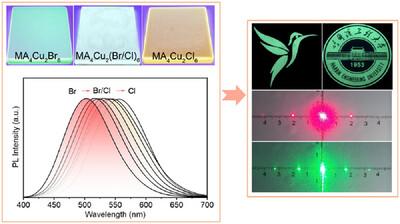Tunable Optical Properties and Enhanced Stability of Organic-Inorganic Hybrid Cu-Based Halide Thin Films for Advanced Anti-Counterfeiting Applications
IF 10
1区 物理与天体物理
Q1 OPTICS
引用次数: 0
Abstract
The development of highly stable and optically tunable materials is crucial for next-generation patterning and anti-counterfeiting applications. This study presents a comprehensive investigation into the synthesis, structural dynamics, and optoelectronic properties of MA4Cu2X6 (X = Cl, Br, Br/Cl) films fabricated via a three-step spin-coating technique. By leveraging halide anion engineering, the precise control over the coordination environment of Cu centers are achieved, as evidenced by synchrotron-based extended X-ray absorption fine structure analysis. Both their strong electron–phonon coupling and high exciton binding energies facilitate efficient self-trapped exciton emission. The photoluminescence emission is tailored from yellow to green and eventually to blue-green under ultraviolet excitation (254 nm). STE localization mitigates thermal quenching, achieving PLQYs >64%. Stability assessments indicate that mixed-halide compositions effectively suppress Cu+ oxidation, prolonging luminescence performance. Mixed halides enhance environmental stability, retaining >25% initial PLQY after 720 h in ambient conditions. Furthermore, the films demonstrate tunable diffraction properties in patterned photonic architectures, highlighting their potential for advanced optoelectronic devices. The films demonstrate high-resolution patterning capabilities via photolithography and screen printing, underscoring their potential for advanced optical security applications.

用于先进防伪应用的有机-无机杂化cu基卤化物薄膜的可调光学特性和增强稳定性
高度稳定和光学可调的材料的发展是下一代图案和防伪应用的关键。本文研究了采用三步旋涂技术制备MA4Cu2X6 (X = Cl, Br, Br/Cl)薄膜的合成、结构动力学和光电性能。利用卤化物阴离子工程,实现了对Cu中心配位环境的精确控制,并通过基于同步加速器的扩展x射线吸收精细结构分析证明了这一点。它们的强电子-声子耦合和高激子结合能都有助于有效的自捕获激子发射。在紫外光激发(254 nm)下,光致发光从黄色到绿色,最终到蓝绿色。STE定位减轻了热淬火,实现了64%的PLQYs。稳定性评价表明,混合卤化物成分能有效抑制Cu+氧化,延长发光性能。混合卤化物增强环境稳定性,在环境条件下720小时后保持25%的初始PLQY。此外,这些薄膜在图像化光子结构中表现出可调谐的衍射特性,突出了它们在先进光电器件中的潜力。这些薄膜通过光刻和丝网印刷展示了高分辨率的图案能力,强调了它们在先进光学安全应用方面的潜力。
本文章由计算机程序翻译,如有差异,请以英文原文为准。
求助全文
约1分钟内获得全文
求助全文
来源期刊
CiteScore
14.20
自引率
5.50%
发文量
314
审稿时长
2 months
期刊介绍:
Laser & Photonics Reviews is a reputable journal that publishes high-quality Reviews, original Research Articles, and Perspectives in the field of photonics and optics. It covers both theoretical and experimental aspects, including recent groundbreaking research, specific advancements, and innovative applications.
As evidence of its impact and recognition, Laser & Photonics Reviews boasts a remarkable 2022 Impact Factor of 11.0, according to the Journal Citation Reports from Clarivate Analytics (2023). Moreover, it holds impressive rankings in the InCites Journal Citation Reports: in 2021, it was ranked 6th out of 101 in the field of Optics, 15th out of 161 in Applied Physics, and 12th out of 69 in Condensed Matter Physics.
The journal uses the ISSN numbers 1863-8880 for print and 1863-8899 for online publications.

 求助内容:
求助内容: 应助结果提醒方式:
应助结果提醒方式:


